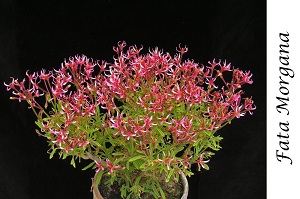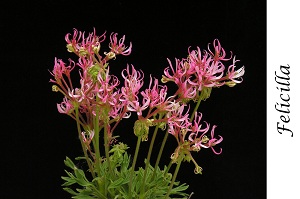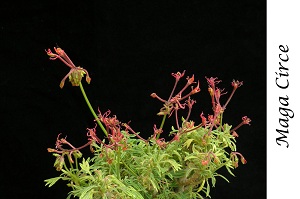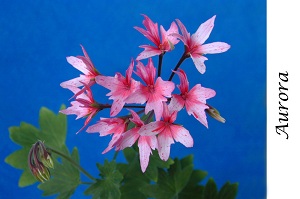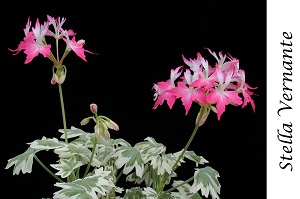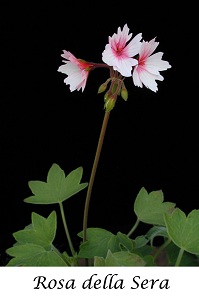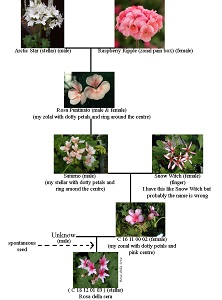Catia De Tomi about herself and her hybrids
 The lovely and cheerful Italian woman Catia De Tomi from Turin, hybridizer of known and favorite varieties of pelargoniums such as 'Rosa della Sera', 'Aurora', 'Stella Vernante', 'Costanza da Schio’ talks about herself, her work and future plans.
The lovely and cheerful Italian woman Catia De Tomi from Turin, hybridizer of known and favorite varieties of pelargoniums such as 'Rosa della Sera', 'Aurora', 'Stella Vernante', 'Costanza da Schio’ talks about herself, her work and future plans.
I’m not a professional hybridizer but all that I have learned by myself, I’m happy to share with other pelargonium fans.
I was involved in hybridization from 1993 to 2004 but then, through a series of troubles, I can no longer grow my plants in a greenhouse and I put an end to my breeding programs. I'm not an old woman and I hope, sooner or later, to be able to resume my favorite growing hobby.
Unfortunately in Italy the pelargoniums have lost much of their popularity due to a terrible parasite (cacyreus marshalli) and to appreciate the beauty of special varieties, such as those that I created, nobody remains.
When I fell in love with the 'strange geraniums' I began, just for fun, to pollinate the plants that I had to get new types of leaves and flowers, because, in Italy, it was always very difficult to find the beautiful varieties that I saw in books or on the web.
At first I just followed the advices of a gardening magazine and the first seedlings were nothing special. But I was not demoralized and I searched for information and suggestions for not proceeding at random.I learned to work on the recessive traits and I took accurate notes on all the crossings and the plants that I got.
So I can satisfy curiosityof many pelargoniumfanson the 'Rosa della Sera' ancestors and give an explanation to the fact that among her children there are often fingers and often fingers very particular with filiform leaves and thin flowers.
I saw on the Web 'Elnaryds Twister’ that a Swedish nursery is selling. This variety is very similar to those I have obtained between 2002 and 2003, from some sisters and grandchildren of 'Rosa della Sera'.
I have thought to give a new name to these particular extreme forms of finger/formosum: medusa. A new name for a never seen types of pelargoniums. A new name like, others have given for recognition and to classify the various types of pelargonium's cultivars. For example: stellar, fancy leaves, paint box, golden leaves...The medusa cultivars are in fact very different from the finger/formosum standard that can be found on the market. I think they, medusa, deserve another category of classification.
Medusa because adult plants often have formed an almost inextricable tangle of leaves and flowers very similar to the snakes on the head of the Greek mythological creature Medusa.To stay on the subject of myths and legends I named some of these most beautiful varieties with the names of 'witches'. Here are some photos of these plants.
When things began to go wrong for my plants, after an intense exchange of letters and photos, I sent nine varieties to one of the famous European nurseries. But they deceived me: after they put the first plants in their catalogue, with enthusiastic words they pushed me to send them 24 other types.They no longer respond to my emails! Maybe they still have some of my plants hidden in their large greenhouses but in recent years they have depleted much of their catalogue and, after having sold successfully eight varieties, now they don’t have them for sale.
Here are the varieties which have been put on the market from 2005 onwards:
‘Aurora’
‘Contessa di Pralormo’
‘Mandala’
‘Stella Vernante’
‘Stella Marinella’
‘Rosa della Sera’
‘Costanza da Schio’
‘Tellina’
The others (including 3 varieties of medusa) I don't know what happened to them, but they were a lot of interesting plants.
Wandering on the internet, to find out how far my plants have gone, I discovered (with the help of the automatic translator of Google) that some people fond of pelargonium on a blog of the Russian language (http://www.forum.kwetki.ru/lofiversion/index.php/t6239-100.html) have obtained from the seeds of 'Rosa della Sera', plants with leaves and flowers very similar to those of my 'medusa’ types.
I was very amused to find that they believe that I have used mutagenic treatments to get 'Rosa della Sera'. No! Only tweezers and years of patience!
Scrolling the page I also saw the photo of my 'Costanza da Schio'. I would tell you - try to also use pollen and seeds of this plant for your hybrids. ‘Costanza da Schio’, probably, has the recessive genes of filiform leaf because it is the sister of 'Felicilla' and 'Morgana'.
Now about the family tree of 'Rosa della Sera'.
I started to use the pollen of the first stellar that I purchased, 'Arctic Star' and a plant that I obtained from a packet of ‘Raspberry Ripple’ seeds as a mother.
When there were few plants, I used provisional names but when I used lots of plants, I started using the codes of letters and numbers. When I produced a beautiful plant I gave it a 'definitive name' but I kept on the labels also the code as a reminder.
In the image of the ancestors 'unknown' and 'spontaneous seed' indicate that I do not have pollinated the ‘C 16 11 00 02’ (female plant) and therefore the male pollen that generated 'Rosa della Sera' may be either of ‘C 16 11 00 02’ that from any of other the plants that bloomed near.
I wish you success in your work and getting new interesting hybrids!
Regards, Catia De Tomi
Remarks
- Cacyreus marshalli Butler – is a butterfly, this South African species, considered a pest of cultivated Pelargonium and Geranium, first arrived in the British Isles in 1997 when an individual was seen flying around Geraniums in a garden in Kingston, Lewes, East Sussex. Immature stages were subsequently found that gave rise to another generation. It is believed that this butterfly was accidentally imported as immature stages in Geranium plants. This butterfly was accidentally introduced first to the Balearic Islands in 1987 and has since spread to much of Spain, France, Italy, Morocco and has even reached Malta.
- In article used the photos by Catia De Tomi.
-
You can share your opinion about this article in the forum: http://pelargonium-species.com/forum.html. Registration required.






















